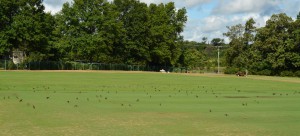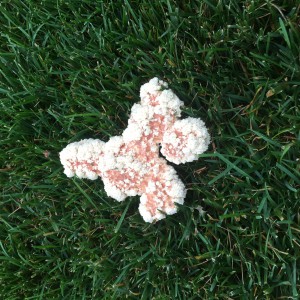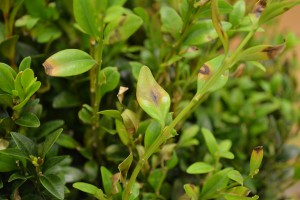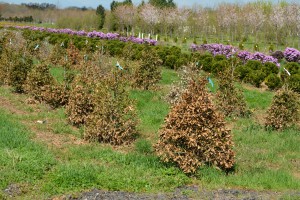Today’s rain got me thinking about insect damage in turfgrass. Actually I’ve been thinking about insect damage in turf for a week or so, ever since I saw a flock of birds pecking sod webworms out of the bentgrass plots behind the Plant Diagnostic Laboratory.
Too Much of Everything is Just Enough
Right along with stormy skies, the Plant Diagnostic Laboratory is firing up with golf turf samples. We’ve seen it all lately: anthracnose, summer patch, slime molds, take-all, Pythium root diseases, annual bluegrass weevils, black turfgrass ataenius, and lots of wear and tear. Here are a couple of random notes from the last week or two:
Borer Mania
Cryptomeria samples have been coming into the Plant Diagnostic Laboratory with increasing frequency this spring. Their issues with winter damage, particularly this year, have been chronicled on this blog. We’ve also had a couple of samples diagnosed with Maskell scale in the lab this spring, too. Pretty routine set of samples, just a few more than usual, until last week that is… [Read more…]
Heads Up, Boxwood Lovers!
A boxwood per day helps keep the doctors away! All of us here in the Plant Diagnostic Lab must be pretty healthy then–since the boxwood blight outbreak in 2013, we get a dose of dead boxwood almost every day.
Take(-all) it to the Limit
A sample diagnosed with take-all patch of creeping bentgrass was the highlight of the turfgrass submissions to the Plant Diagnostic Laboratory this week. This sample marks the first in the seasonal transition on golf courses from diseases common to late-winter and early-spring (snow molds/yellow patch) to the late-spring and early-summer problems (take-all/brown ring patch). Yes, it was an exciting day for the turfgrass pathologist!
Winter’s Continuing Legacy
Despite a winter we all want to forget, it never ends if you are a pathologist. Everywhere I look there is plant damage due to the extreme winter. Broad-leaved evergreens seemed to take it hard again this year, particularly some of the hybrid hollies. Frozen roots and heavy winds, along with the need to transpire on sunny winter days, left them in shambles. The injury was visible early and often.





